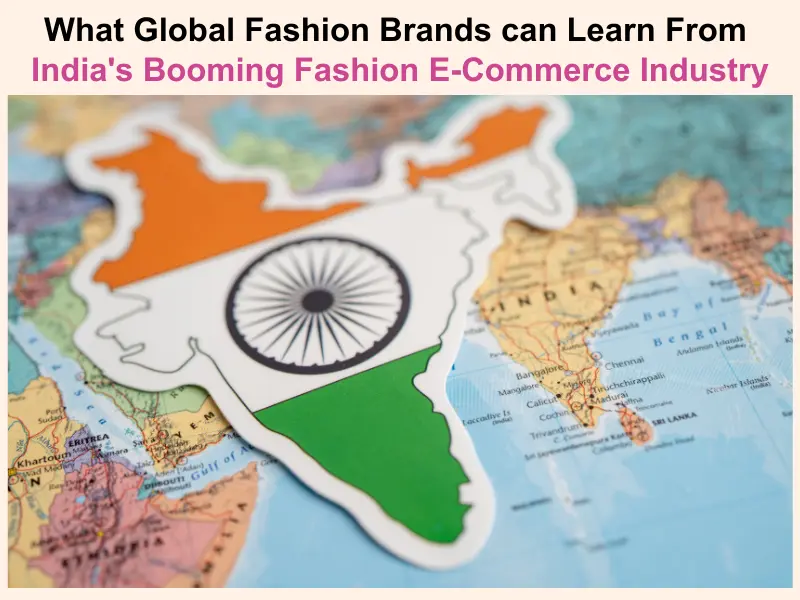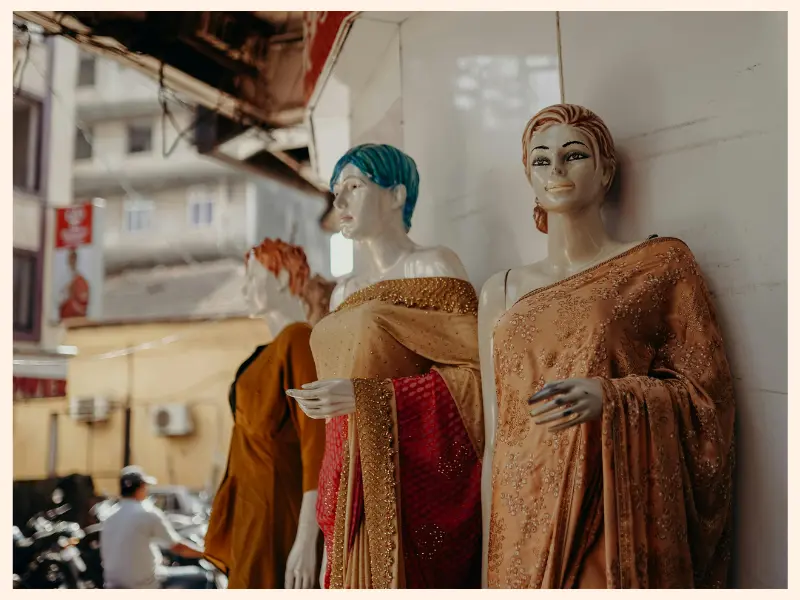The Indian fashion e-commerce market is booming, fueled by a young population and rising internet use. Learn how global brands can adapt and thrive in this dynamic market. Discover key strategies for success, from catering to local preferences to building trust and leveraging data.
The Indian fashion e-commerce market is experiencing phenomenal growth, fueled by a young, tech-savvy population, rising disposable incomes, and increasing internet penetration.
As the world’s second-largest internet market, India offers valuable insights into how fashion brands can innovate, adapt, and thrive in a digital-first world.
In this article, we’ll explore the key lessons global fashion brands can learn from India’s e-commerce success stories.

A Market on the Rise:
- According to Redseer Consulting, the Indian fashion e-commerce market is expected to reach a staggering USD 35 billion by 2024, growing at a compound annual growth rate of 12%.This surge is driven by a massive youth population (over 600 million under 35) with a growing appetite for online shopping.
- Shopify reports a 48% increase in online fashion sales in India during the pandemic, highlighting the accelerated shift towards e-commerce.
What can global brands learn from successful Indian brands?
Several Indian D2C fashion brands like Bewakoof and Myntra have disrupted the market with their innovative approach, showcasing the potential for niche players to thrive.
Unlike traditional retailers catering to a broad audience, these niche players have carved out their own space by deeply understanding the specific needs and preferences of their target demographics.
Bewakoof, for example, caters to the youthful segment with quirky and trendy designs. By focusing on this niche, they can curate product lines that resonate directly with this audience, offering a more targeted and relevant shopping experience compared to one-size-fits-all retailers.
Additionally, D2C brands like Myntra leverage technology to analyze customer data and identify emerging trends in real-time. This allows them to adapt their offerings quickly and bring on-demand styles to their platform, staying ahead of the curve and exceeding customer expectations.
This customer-centric approach, combined with a laser focus on specific demographics, has allowed D2C brands to disrupt the market and establish themselves as major players in the Indian fashion e-commerce scene.
Indian brands are innovating and thriving in unique ways. Here are some success stories and valuable lessons for global brands to consider:
- Understanding the Local Customer:
- Global Brands, Local Touch:
- Mobile-First Approach:
- Building Trust & Community:
- Hyper-Personalization & Data-Driven Decisions:
- Logistics & Delivery Innovation:
Going Beyond Borders:
These labels are showcasing the exquisite craftsmanship and rich cultural heritage woven into every stitch of Indian clothing. From the intricate embroidery and hand-woven textiles to the bold colors and flowing silhouettes, Indian fashion is sure to captivate international audiences and redefine the global fashion landscape.
Key Takeaways for Global Brands:
- Cater to local preferences – Research cultural nuances and adapt your offerings.
- Embrace mobile commerce – Optimize your website and app for a seamless mobile experience.
- Build trust and community – Offer COD options and foster engagement through social media.
- Personalize the experience – Use data to tailor recommendations and promotions.
- Innovate in logistics – Offer quick and affordable delivery options.
- Think global – The success of Indian brands shows the potential for international expansion.

Is it a good idea for a global brand to enter the Indian market?
The Indian fashion e-commerce market is a goldmine waiting to be explored. With a projected value of $35 billion in 2024 and a growing internet-savvy population, India presents a massive opportunity for global brands. But is it a guaranteed success story?
Let’s weigh the pros and cons:
The Alluring Potential:
- A Booming Market: India’s fashion e-commerce is experiencing explosive growth, fueled by rising disposable incomes and increasing internet penetration. This translates to a vast and eager customer base for global brands.
- Tech-Savvy Consumers: Indians are embracing online shopping, especially through mobile apps. This opens the door for global brands to leverage their digital expertise and offer a seamless mobile shopping experience.
- Evolving Tastes: Indian consumers are increasingly fashion-conscious, seeking a blend of global trends and local aesthetics. Global brands can offer a unique selection that caters to this evolving taste.
Challenges to Consider:
- Local Powerhouses: The market is not a vacuum. Homegrown brands like Myntra and Nykaa understand the local preferences deeply and offer competitive prices. Global brands need a strong strategy to stand out.
- Price Sensitivity: While disposable incomes are rising, value still holds significant weight for Indian consumers. Balancing international quality with competitive pricing is crucial.
- Logistics & Infrastructure: India’s vast geography can present logistical challenges. Delivering efficiently and affordably across the country requires a robust supply chain network.
Making it Work: Lessons from the Forerunners:
Global brands like H&M and Zara have found success by adapting their strategies for the Indian market. Here’s what they’ve done:
- Localized Collections: Offer designs that incorporate local trends and sensibilities, showcasing a commitment to the Indian market.
- Mobile-First Approach: Ensure their website and app are optimized for a smooth mobile shopping experience, catering to India’s mobile-driven consumers.
- Building Trust: Offering Cash on Delivery (COD) options to build trust and encourage online shopping.
- Engaging with the Community: Utilize social media to connect with Indian customers, understand their preferences, and build brand loyalty.
The Final Verdict?
The Indian fashion e-commerce market offers immense potential for global brands, but it’s not without its challenges. Careful planning, strategic adaptation, and a customer-centric approach are key to success. By learning from the success stories of existing players and addressing the specific needs of the Indian market, global brands can navigate the challenges and capitalize on the exciting opportunities India presents.
Beyond the Basics: Advanced Strategies for Global Fashion Brands in India
1. Building Brand Trust and Community:
Hyper-personalization: Leverage customer data to offer personalized recommendations, targeted promotions, and loyalty programs that foster a sense of connection.
Social Commerce Integration: Integrate social media platforms like Instagram and Facebook Shops into your e-commerce strategy. Encourage user-generated content (UGC) through contests and hashtags to build a community around your brand.
Customer Service Excellence: Provide exceptional customer service through multiple channels, including chatbots, phone support, and social media messaging. Address inquiries promptly and efficiently to build trust and loyalty.
2. Partnering for Success:
Collaborations and Co-branding: Partner with established Indian fashion brands or influencers to co-create limited-edition collections or leverage their local reach.
Strategic Alliances: Collaborate with Indian logistics companies to optimize delivery networks and explore options like same-day delivery for select regions. Partner with local payment gateways familiar with Indian consumer preferences (e.g., UPI, wallets).
3. Leveraging Data and Analytics:
Go beyond demographics: Utilize user behavior data to understand customer preferences, purchase patterns, and popular styles. This data can inform product development, marketing strategies, and campaign optimization.
Embrace AI and Machine Learning: Implement AI-powered tools for product recommendations, targeted advertising, and dynamic pricing strategies to cater to the diverse Indian market.
As the global e-commerce landscape continues to evolve, the success of India’s fashion e-commerce market serves as a powerful example of how innovation, adaptability, and a customer-centric approach can drive growth and success.
By adopting these advanced strategies, Global fashion brands can learn so much from the growing e-commerce brands of India by gaining valuable insights and adapting to a dynamic and future-oriented fashion landscape. You can also embrace the unique opportunities India presents, and watch your brand flourish in this vibrant and growing market.
About the author(s):
Natasha is our Social Media Manager, a law student, and marketing enthusiast. She loves strategizing different methods to get results. A big fan of startups and their psychological aspects. She loves to travel and interact with locals to know the history of those places. She lives in Jaipur, India.